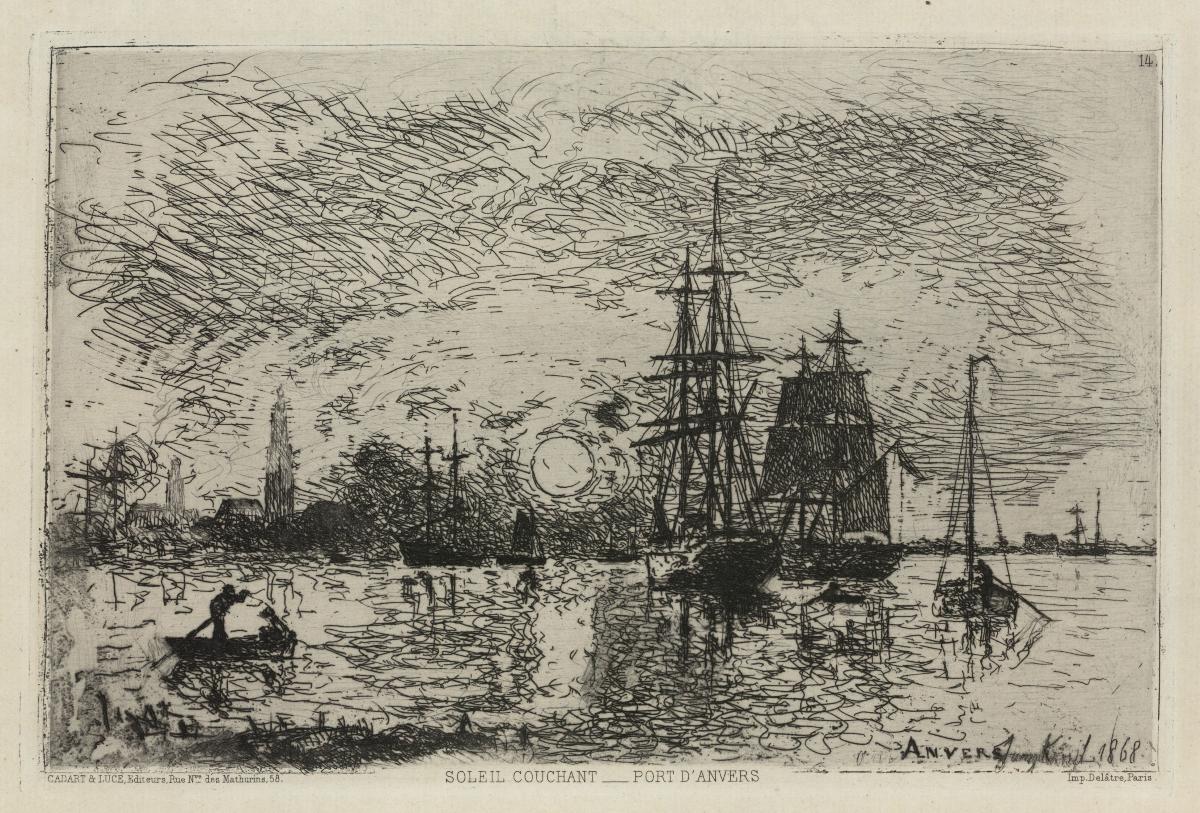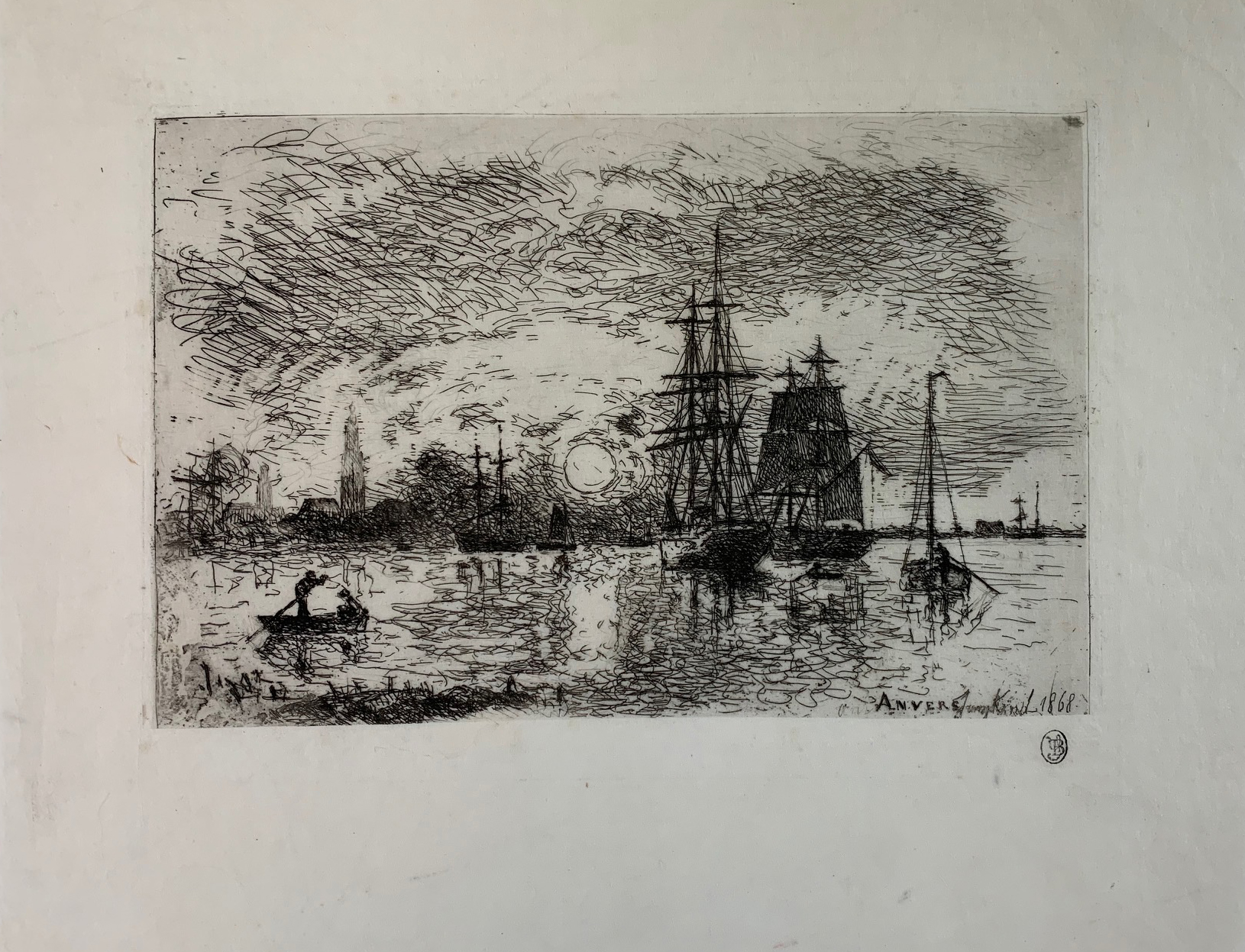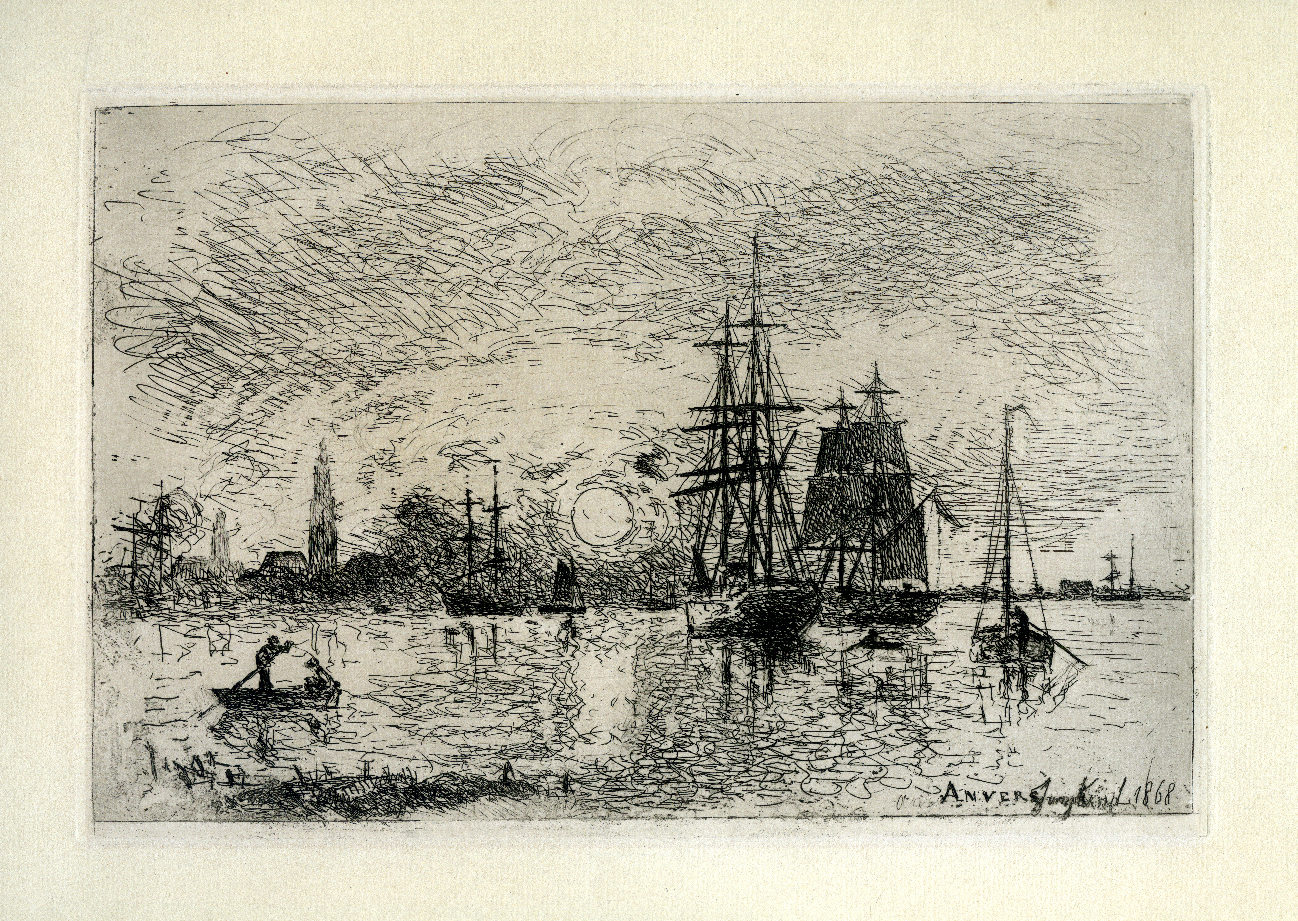
|
|
Soleil Couchant
, Port d'Anvers
[Sunset, Port of Antwerp]
Delteil 15.1
etching, 1868, the extremely rare first
state (of four), a superb and atmospheric trial impression,
before all letters, on medium-weight
cream laid paper, with the Hudelist watermark, with good
(although irregular) margins, remains of old tape on the far sheet
edges, verso, with slight
resultant staining, otherwise in quite excellent condition
P. 160x240mm., S. 298x322mm.

Provenance: a
private Parisian collection
|

The present
first-state impression is exceptional for several reasons, here printed
quite refinedly in comparison with the regular Cadart first edition
(cf. the MAH impression*, right),
which is rather more thickly and
indiscriminately inked (i.e., saucé
as the French say), and it is in exceptional condition, with good
margins, never having been framed or exposed to light.
This etching is also generally considered to be Johan Barthold
Jongkind's masterpiece.
Delteil in his
introduction to the catalogue raisonné**
proffers an alert description:
"... en 1868, Soleil
couchant, Port d'Anvers,
son chef-d'œuvre, sans contredit : on ne saurait rendre avec plus de
simplicité et d'esprit à la fois, les vibrations de la lumière, la
sensation de l'air, la limpidité de l'eau, la réverbération..."
[...in 1868, Sunset,
Port of Antwerp,
his masterpiece, without a doubt: one could not render with greater
simplicity and spirit at the same time, the vibrations of light, the
sensation of air, the clarity of the water, the reverberation..."]
It is
worthwhile here to examine several successive states. Comparison
may be fruitfully made with an interesting impression of Delteil's
third state, the letters rigorously burnished out and the number 14, (in the upper right corner),
finely scratched over,
on tissue-thin laid Japon
paper (with a prestigious
provenance from the Beurdeley
collection), which was recently sold in the UK***, and which we have also been able to examine first-hand (below, right).

Delteil
identifies late faux avant-lettre impressions, which are to be distinguished from true first-state impressions.
Here, it
is evident that the burnishing of the letters along the full lower
borderline also removed several millimeters of the original
composition, which is an easy observation.
Another
obvious criterion is the paper type. We know that Jongkind's
printer, Auguste Delâtre, regularly had recourse to fine hand-made paper
with the Hudelist and Hallines
watermarks in the 1860's (which were both made, incidentally,
in the same mill
on the Aa River in the Pas de Calais).
There are
for example early
impressions on Hudelist paper
from Jongkind's 1862 Cahiers de Six
Eaux-Fortes, before letters, from the Doucet Collection, now
held in the INHA collections at the Bibliothèque Nationale:
-
https://bibliotheque-numerique.inha.fr/collection/item/17609-les-maisons-au-bord-du-canal?offset=18079
-
https://bibliotheque-numerique.inha.fr/collection/item/17613-les-deux-barques-a-voile?offset=4
And the INHA impression of the first state of Soleil couchant is pulled on Hallines:
-
https://bibliotheque-numerique.inha.fr/collection/item/17620-soleil-couchant-port-d-anvers?offset=5
(Unfortunately,
the mediocre quality of the imaging online does not really allow for a
full appreciation of their quality.)
In
conclusion, given the celebrations organized in 2022 for the 150th
anniversary of Claude Monet's renowned picture Impression, Soleil Levant****, it is worthwhile to recall his graciously acknowledged
debt to Jongkind, after their first meeting in 1862:
"Il fut, à partir de ce
moment, mon vrai Maître, c'est à lui que je dois l'éducation définitive
de mon œil."
["He was, from that
moment, my true Master, it is to him that I owe the definitive
education of my eye."]
We know
too that Jongkind often gave Monet fine impressions of his prints with
warm dedications, and it would indeed be appropriate here to recognize
the probable influence of the present etching as a source of inspiration
for Monet's masterpiece.
* See the Musée d'art et d'Histoire de Genève website:
https://collections.geneve.ch/mah/oeuvre/soleil-couchant-port-danvers/e-2019-0522
** See Löys Delteil, Le Peintre-Graveur Illustré: Millet,
Rousseau, Duprés, Jongkind, 1906, Tome I: page 101
***
See the Forum Auctions, London sale, Lot 88, held on 11 March 2021
**** See the Musée Marmottan exhibition
https://www.marmottan.fr/expositions/le-soleil-se-leve-tous-les-jours/




